In a quiet corner of Ipoh, a new EV charger hums beside a row of food stalls. It’s not flashy—just a slim column with a blinking light—but for the stall owners, it’s a sign that things are changing. “People ask about it all the time,” says Hafiz, who sells nasi lemak nearby. “They want to know if it’s safe, if it’s fast. Some just want to touch it.”
Malaysia has now installed over 4,100 public EV chargers nationwide, including 956 DC fast chargers and 2,398 AC units. The goal is 10,000 by 2025. But the real milestone isn’t the number—it’s the shift in public imagination. Infrastructure is becoming visible, tangible, and quietly reassuring.
MEVnet, the national EV dashboard, lets users check charger status in real time. It’s a small gesture, but it turns uncertainty into confidence. For Hafiz and his customers, it’s proof that the future isn’t just coming—it’s arriving, one charger at a time.
The Bus That Drives Itself
Putrajaya’s streets are wide and orderly, designed for a future that’s always felt just out of reach. But now, that future is rolling through the city—slowly, silently, and without a driver.
Malaysia’s first 5G-powered autonomous electric bus is undergoing trials in the administrative capital. It uses real-time telemetry, AI navigation, and in-vehicle Wi-Fi to connect passengers with the city around them. The bus isn’t just a vehicle—it’s a prototype for how public transport might feel: clean, connected, and quietly intelligent.
But the trial also exposes gaps. Malaysia still lacks legal frameworks for autonomous vehicles. Safety standards, insurance models, and data governance are works in progress. The technology is ready. The policy is catching up. And the public? Curious, cautious, and increasingly open.
Investing in a Systems Shift
Malaysia’s green mobility push is backed by a web of policies and plans. The National Automotive Policy (NAP) 2020 laid the foundation. The Low Carbon Mobility Blueprint 2021–2030 added structure. The National Energy Transition Roadmap (NETR), launched in 2023, raised the stakes—targeting 70% renewable energy in the power mix by 2050.
These aren’t just climate documents. They’re blueprints for a new kind of public life. The government aims for 80% EV adoption and 90% local EV manufacturing by 2050. RM26.2 billion has already been invested in EV ecosystem projects, including Tesla’s regional HQ in Kuala Lumpur.
But the real shift is emotional. Mobility is being reframed—from private status to public care.
Building a Rural Road in Kelantan
Rural and semi-urban areas remain underserved. While urban centres like Kuala Lumpur and Johor Bahru see rapid electrification, smaller towns lag behind. Without targeted investment, the transition risks deepening mobility divides.
Gentari’s rural deployment strategy offers hope. By partnering with local councils and placing chargers in community hubs, they’re making clean mobility feel local, not elite. But more is needed—especially in terms of public transport routes, fleet upgrades, and service quality.
The Grid Beneath It All
Electrifying transport only works if the grid is clean. Malaysia’s NETR aims to shift the power mix toward renewables—solar, hydro, biomass, and hydrogen. Biodiesel blends (B10 to B20) are being expanded in public fleets. Hydrogen development is projected to generate RM400 billion in revenue and 200,000 jobs, with pilot projects in ammonia co-combustion and fuel cell deployment.
These aren’t just technical upgrades. They’re public commitments. When a bus runs on solar power, it carries more than passengers—it carries a promise of shared wellbeing.
What Comes Next
Malaysia’s green mobility story is still unfolding. The infrastructure is growing. The policy is evolving. The public is watching.
But the transition must be emotionally sustainable. It must feel inclusive, not imposed. It must offer relief, not just reform. That means expanding rural access, electrifying public fleets, and designing systems that reflect everyday needs.
It means asking: Who gets to move easily? Who gets left behind? And how can transport become a source of care, not just carbon reduction?
Malaysia has the tools. It has the vision. Now it needs to keep listening—to stall owners in Ipoh, students in Kelantan, and everyone in between.
For more news and insights, stay tuned to the AIC website.

